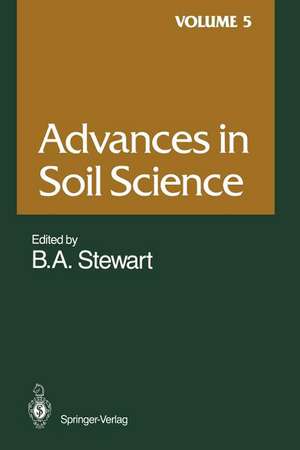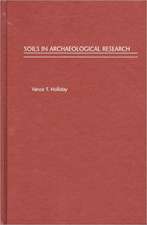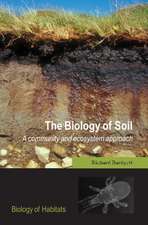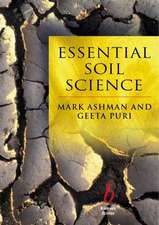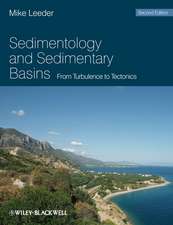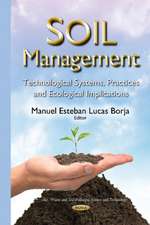Advances in Soil Science: Volume 5: Advances in Soil Science, cartea 5
Contribuţii de S.K. De Datta, M. P. W. Farina, R. Lal, P.K. Sharma, D.E. Smika, M.E. Sumner, P.W. Unger, G. Zitongen Limba Engleză Paperback – 8 noi 2011
Din seria Advances in Soil Science
-
 Preț: 444.08 lei
Preț: 444.08 lei -
 Preț: 448.67 lei
Preț: 448.67 lei - 25%
 Preț: 427.84 lei
Preț: 427.84 lei - 15%
 Preț: 467.93 lei
Preț: 467.93 lei - 18%
 Preț: 1954.45 lei
Preț: 1954.45 lei - 12%
 Preț: 312.43 lei
Preț: 312.43 lei -
 Preț: 374.21 lei
Preț: 374.21 lei - 25%
 Preț: 941.40 lei
Preț: 941.40 lei -
 Preț: 448.44 lei
Preț: 448.44 lei - 18%
 Preț: 1289.11 lei
Preț: 1289.11 lei - 15%
 Preț: 473.34 lei
Preț: 473.34 lei - 18%
 Preț: 1304.13 lei
Preț: 1304.13 lei - 22%
 Preț: 464.32 lei
Preț: 464.32 lei - 18%
 Preț: 1300.62 lei
Preț: 1300.62 lei - 18%
 Preț: 1941.67 lei
Preț: 1941.67 lei - 18%
 Preț: 1284.86 lei
Preț: 1284.86 lei - 15%
 Preț: 461.03 lei
Preț: 461.03 lei - 18%
 Preț: 1290.23 lei
Preț: 1290.23 lei - 18%
 Preț: 1119.62 lei
Preț: 1119.62 lei - 18%
 Preț: 1290.71 lei
Preț: 1290.71 lei - 18%
 Preț: 1233.70 lei
Preț: 1233.70 lei - 15%
 Preț: 641.38 lei
Preț: 641.38 lei - 15%
 Preț: 636.63 lei
Preț: 636.63 lei - 15%
 Preț: 643.84 lei
Preț: 643.84 lei - 15%
 Preț: 637.46 lei
Preț: 637.46 lei - 15%
 Preț: 701.59 lei
Preț: 701.59 lei - 15%
 Preț: 636.30 lei
Preț: 636.30 lei - 15%
 Preț: 639.59 lei
Preț: 639.59 lei - 15%
 Preț: 638.43 lei
Preț: 638.43 lei - 15%
 Preț: 648.89 lei
Preț: 648.89 lei - 15%
 Preț: 641.71 lei
Preț: 641.71 lei - 15%
 Preț: 637.59 lei
Preț: 637.59 lei -
 Preț: 385.47 lei
Preț: 385.47 lei - 15%
 Preț: 641.85 lei
Preț: 641.85 lei - 15%
 Preț: 637.28 lei
Preț: 637.28 lei - 15%
 Preț: 637.59 lei
Preț: 637.59 lei - 15%
 Preț: 637.46 lei
Preț: 637.46 lei - 15%
 Preț: 637.93 lei
Preț: 637.93 lei -
 Preț: 384.70 lei
Preț: 384.70 lei - 15%
 Preț: 637.28 lei
Preț: 637.28 lei - 26%
 Preț: 1414.85 lei
Preț: 1414.85 lei
Preț: 638.57 lei
Preț vechi: 751.25 lei
-15% Nou
Puncte Express: 958
Preț estimativ în valută:
122.21€ • 127.11$ • 100.89£
122.21€ • 127.11$ • 100.89£
Carte tipărită la comandă
Livrare economică 14-28 aprilie
Preluare comenzi: 021 569.72.76
Specificații
ISBN-13: 9781461386629
ISBN-10: 1461386624
Pagini: 256
Ilustrații: IX, 242 p.
Dimensiuni: 155 x 235 x 13 mm
Greutate: 0.37 kg
Ediția:Softcover reprint of the original 1st ed. 1986
Editura: Springer
Colecția Springer
Seria Advances in Soil Science
Locul publicării:New York, NY, United States
ISBN-10: 1461386624
Pagini: 256
Ilustrații: IX, 242 p.
Dimensiuni: 155 x 235 x 13 mm
Greutate: 0.37 kg
Ediția:Softcover reprint of the original 1st ed. 1986
Editura: Springer
Colecția Springer
Seria Advances in Soil Science
Locul publicării:New York, NY, United States
Public țintă
ResearchCuprins
Soil Surface Management in the Tropics for Intensive Land Use and High and Sustained Production.- I. Introduction.- II. Land, Rainfall, and Vegetation.- III. Soil Resources of the Tropics.- IV. Traditional Farming Systems and Soil Productivity.- V. Soil Degradation and Ecological Fragility in the Tropics.- VI. Basis of Improving Traditional Farming Systems.- VII. Components of Technology for Improving Traditional Agriculture.- VIII. An Agroecological Approach to Improving Traditional Agriculture in the Tropics.- IX. Research and Development Priorities.- References.- Effect of Surface Residues on Soil Water Storage.- I. Introduction.- II. Early Studies with Surface Residues.- III. Stubble Mulch Tillage.- IV. Early Chemical Fallow (No Tillage).- V. Chemical Fallow with Improved Herbicides.- VI. Managing Irrigated Crop Residues.- VII. Residue Effects—Subhumid and Humid Regions.- VIII. Surface Residue Effects on Evaporation.- IX. Surface Residue Effects on Water Conservation from Snow.- X. Summary and Conclusions.- References.- Physical Properties and Processes of Puddled Rice Soils.- I. Introduction.- II. The Puddling Process.- III. Puddling Indices.- IV. Effects of Puddling.- V. Regeneration of Soil Structure.- VI. Is Puddling Essential?.- VII. Research Gaps.- VIII. Summary.- References.- Origin, Evolution, and Classification of Paddy Soils in China.- I. Paddy Soils of China.- II. Distribution of Paddy Soils in China.- III. Genesis of Paddy Soils.- IV. Genetic Horizons of Paddy Soil.- V. Classification of Paddy Soils.- VI. A Suggestion of Paddy Soil Classification in Soil Taxonomy.- References.- Phosphorus Interactions with Other Nutrients and Lime in Field Cropping Systems.- I. Introduction.- II. Interpretive Model.- III. Phosphorus × Nitrogen.- IV. Phosphorus ×Zinc.- V. Phosphorus × Lime.- VI. Phosphorus × Silicon.- VII. Phosphorus × Iron.- VIII. Phosphorus × Copper.- IX. Phosphorus × Potassium.- X. Phosphorus × Sulfur.- XI. Phosphorus × Molybdenum.- XII. Phosphorus × Magnesium.- XIII. Other Interactions.- XIV. A Look to the Future.- References.
